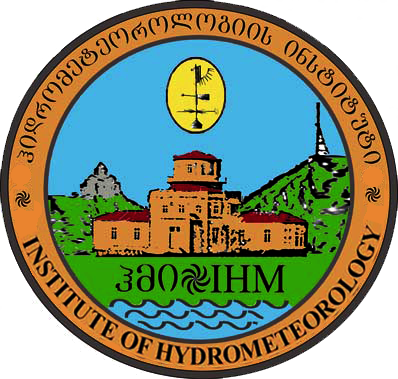TBILISI GEOPHYSICAL OBSERVATORY AND ITS ROLE IN DEVELOPING
THE HYDROMETEOROLOGICAL SCIENCE IN GEORGIA
THE HYDROMETEOROLOGICAL SCIENCE IN GEORGIA
Since the beginning of 1830es under the initiative of Acad. A.Kupffer the systematic magnetic and meteorological observations had began at different sites of the Russian Empire. One of the observatories of this kind was the Tbilisi Magnetic-Meteorological Observatory which started its functioning in 1837. After some changes in location the observatory finally had setted in the district of Kukia at the new building, specially erected for the observatory in 1860-1861 according to the design by O.Simonson. This building still stands at its initial place at the address: David Agmashenebeli Ave,150g and hosts the Institute of Hydrometeorology under the Georgian Technical University. By the end of XIX century observations of different profiles in Geophysics were being conducted in the observatory, among them magnetic, meteorological, seismic, gravimetric, as well as astronomical observations. In the beginning of XX century the actinometrical and aerological observations were added to the program. About 60 weather stations and posts were functioning at that time in the meteorological network. The results were systematically submitted to the Potsdam Word Data Center and had been gaining high appreciation.

Fig.1. General view of the Tbilisi Magnetic -Meteorologial Observatory (1865)
For about half a century the observatory was led by well known German scientists (A.Moritz, H.Abich, J.Mielberg, etc.) who selected talented local young people as observers. One of them was Joseph Jugashvili (later on–Stalin) serving in the observatory in 1899-1901 .
Before the beginning of World War 1 in 1914 German specialists had left Tbilisi that drastically affected the quality of observations carried out in the observatory. Since that time number of changes had occurred in the life of observatory: magnetic observations were transferred first to Karsani (1905) near Mtskheta and later to Dusheti (1935). The astronomical observations since 1932 were relocated to Abastumani and seismic observations were moved to Delisi, the suburb of Tbilisi, while the meteorological observations-to Dighomi in the northwestern edge of the city. During the October Revolution of 1917 and the following civil unrest of 1918-1924, the observatory was almost paralyzed. Its restoration has actually started since 1924, when well-known Georgian scientists – Professors A.Benashvili, A.Didebulidze, R.Khutsishvili and M.Nodia managed to revitalize the functioning of Observatory. This process was strongly promoted by setting up in 1929 on the basis of Tbilisi Geophysical Observatory the State Committee on Hydrometeorology, which incorporated by 1980es about 440 observation sites over the territory of Georgia, 240 of them being the meteorological stations. As to the title of the observatory, in 1867 the MagneticMeteorological name was changed to Tbilisi Physical Observatory and since 1924 it was renamed to Tbilisi Geophysical Observatory (TGO). In 1933, within the system of Academy of Sciences the Institute of Geophysics has been organized, to which the Seismic Department of the Observatory was conveyed. Hence, since 1932-1933 when the Abastumani Astrophysical Observatory and Institute of Geophysics were singled out from the Tbilisi Geophysical Observatory, the following step in the development of TGO could be considered 1953, when the Tbilisi (later the Transcaucasian Regional) Hydrometeorological Research Institute has been founded, under the Decree signed by J.Stalin.
At the initial stage of its operation (1953-1968) the Institute, housed in the dilapidated building of TGO, closely followed the objectives prescribed by the Decree, focused mainly on weather forecasting and providing the Agriculture with climate data. However, since the beginning of 1960es the weather modification and monitoring of environmental pollution have gained the momentum and moved to the top items category. Correspondingly the Institute has updated its priorities and sent young specialists to the leading hydrometeorological centers of the USSR to upgrade their professional skills. All these processes were profoundly managed by the first Director of the Institute Dr. V.Lominadze. Taking into consideration his decadelong successful activities, it was decided in 1963 to transform the Institute into Regional Transcaucasian scientific center and construct the proper building for its accommodation. This objective has been attained in 1968 and in 1969 the Institute was already able to host the International Conference on Weather Modification, followed later by many other meetings of such kind. The Institute has established separate Departments in Baku and Yerevan, comprising total number of employees up to 600. The new 9-storey building of the Institute (Fig.4) housed all scientific Departments and laboratories, vast library and conference hall, computer centre and the cloud chamber, intended for modeling precipi- tation forming processes at above freezing temperature, apartments of the Managerial team. The new building and auxiliary premises were situated nearby the TGO historic building, shadowing unfortunately the meteorological observation site.
At the following stage of activities (1968-2005) the Institute was engaged in solving vast variety of problems, including weather modification and climate change, water resources and agricultural climatology, environmental pollution and modeling of related processes. After the sudden death of Dr. V.Lominadze in 1975, his course was successfully continued by Acad. G.Svanidze who has ruled the Institute in 1976-1999. Following Acad. G.Svanidze the Institute was directed by N.Begalishvili (1999-2008) and N.Tsintsadze (2008 up to now) who adapted the Institute to new realities. After the collapse of the Soviet Union, in 1993 the Institute was incorporated in the system of Georgian National Academy of Sciences and in 2010 – in the Georgian Technical University (GTU). Excess space, emerged as a result of disintegrating the USSR, has provoked the annexation in 2005 of the 9-storey building by the Ministry of Defense, disposed nearby. Hence, the Institute finally has returned to the TGO old building and is continuing its operation within its old limits.
Taking into consideration the immense share made by German scientists in setting up, construction and functioning of TGO till 1914, the Institute since 1995 has tried for several times to evoke the interest of the German Embassy to setting up of joint German-Georgian cultural and scientific center on the basis of TGO, but the rotation of German staff made it impossible to realize this idea. The first decisive step in this direction was taken by the grandchild of Prof. M.Nodia Dr. Maia Mania who published in 2010 under the support of the Goethe Institute the fundamental monograph “Tbilisi Geophysical Observatory. History and Architecture”. Following this publication the TGO building has established its rightful place among the historic monuments of Tbilisi. Another opportunity has appeared in 2017, when the bicentennial of
German colonists’ arrival in Georgia was commemorated. However, the competition for jubilee celebration has been won by the village Asureti which has received the funding alloted for the rehabilitation of infrastructure.
The third period of Institute’s activities could be counted since 2005 when it came back to its initial housing. Presently the Institute consists of 4 Departments: Water resources and hydrological forecasts, Climatology and Agricultural Meteorology, Monitoring and Forecasting of environmental pollution and Weather forecasting, Modeling of Natural and Technogenic hazards. Through 1997-2015 the Institute actively participated in the preparation of Georgia’s Initial, Second and Third national Communications to the UNFCCC. In recent decade more than 20 monographs, textbooks and Atlases have been published by the Institute on Georgia’s climate, climate and agroclimatic resources, disastrous events, among them floods and snow avalanches. The detailed study of Georgia’s glaciers using satellite data is in progress and the compilation of Georgian snow avalanches’ and rivers’ Atlases is nearing its end.
Members of the Institute are actively participating in the implementation of scientific grants by the Shota Rustaveli National Science Foundation, are taking part in various scientific meetings held in different countries, are delivering lectures at the Georgian Technical University. The Institute annually holds the traditional May scientific sessions, the materials of which are periodically published in referable Proceedings of the Institute. By the way, more detailed information about the Tbilisi Geophysical Observatory and scientific institutions, set up on its basis, could be found in the following references:
1. Mania M. Tbilisi Geophysical Observatory. History and Architecture.Goethe Institute Georgien. Tbilisi, 2010.
2. Collection of papers dedicated to 150-th anniversary of Tbilisi Geophysical Observatory. “Metsniereba”, Tbilisi, 1997 (in Georgian).
3. Institute of Hydrometeorology of the Georgian Academy of Sciences (For the 50-th anniversary of foundation).Tbilisi, 2003.
4. Ivane Javakhishvili Tbilisi State University Mikheil Nodia Institute of Geophysics -80.Tbilisi State University, Tbilisi, 2013 and The M.Nodia Institute of Geophysics 1933-2013. www.iggeophysics.ge

